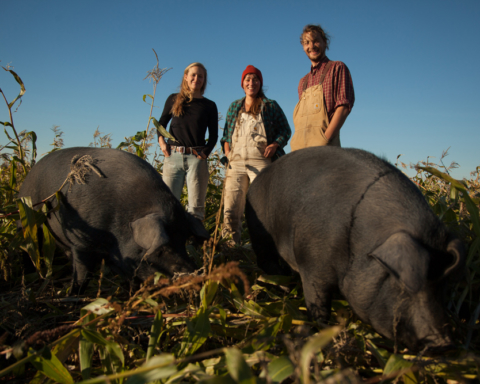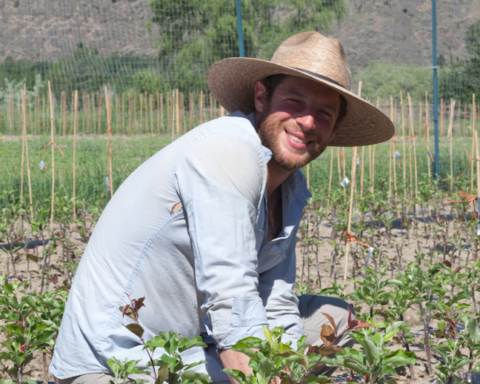A Culture of Caring For Our Children’s Children
Marjorie Harris BSc, IOIA V.O. P.Ag
This past year offered me a renewed and greater depth of understanding for the foundations of organic agriculture that are steeped in a culture of caring and concern for how the long term ramifications of today’s actions will affect tomorrow’s world.
One of my field-person positions required that I obtain a pesticide applicator’s licence. As I worked through the educational material provided through the BC government training program, I was taken aback to read that certain pesticides have been identified that have the ability to kill the soil irreversibly. I do not comprehend how any substances in this category of lethality could even be considered for agricultural use.
Soil fertility is a primary concern for organic and regenerative agriculture. To quote Rodale, “healthy soil, healthy plants, healthy people”. This quote and concept makes a lot of sense to me. The healthier the soil, the more microbes and fungi systems available to actively deliver nutrients to the plants. More nutrients help plants develop strong immune systems and robust growth that ultimately translate into more phytonutrients created per plant. These well fed, healthy plants supply those proteins, carbohydrates, minerals, vitamins, and species unique phytonutrients to the human dinner plate.
The culture of caring for soil fertility over the long term in organic agriculture is in stark contrast to the concept that there would be legitimate reasons to knowingly kill the soil through conventional agriculture methods. This concept was shocking and foreign to me and made me immediately more deeply thankful for the organic culture of caring for the living earth.
The basic Canada Organic Standard requires a buffer zone that can offer growers an opportunity to build in biodiversity zones. The Demeter Canada inspection forms demonstrate an example of deeper long term caring. Here, reflection on caring for, and protecting ancient forest soils and their living biodiversity, is implied in questions:
3.9 No clearing of virgin forest or high value conservation areas.
3.10 Is 10% of the productive farm area a biodiversity reserve?
The biodynamic practice of protecting undisturbed forest soils for future generations is supported by current scientific evidence, which has found that the ectomycorrhizal fungi of the forest can absorb 30% more human created carbon dioxide under low nitrogen conditions than grassland and agricultural soils dominated by arbuscular fungi.
The roots of forest plants are closely associated with their ectomycorrhizal fungi that can deliver extra atmospheric carbon dioxide directly to the plant, causing a 30% increase in growth—this is termed the ‘fertilization effect’. In a recent study into the fertilization effect, the research team analysed 83 carbon dioxide fertilization experiments, which demonstrated that a plant’s ability to take advantage of extra CO2 depended on whether the roots were associated with ectomycorrhizal or arbuscular fungi. The forest-type ectomycorrhizal won hands down every time with an extra 30% plant growth. The arbuscular fungi in the agricultural/grassland was not able to take advantage of higher carbon dioxide levels at all. (Terrer, et al., 2016)
It was determined that the arbuscular fungi need higher levels of nitrogen in the soil compared to the forest ectomycorrhizal fungi, which are able to absorb soil nitrogen even under low nitrogen conditions. The ability to absorb soil nitrogen determines how much carbon dioxide can be absorbed to fertilize the plants into extra growth. During this time of climate change concern, forests and forest soils are a real and measurable ally for their ability to sequester and reduce the increasing atmospheric carbon dioxide levels and therefore help stabilize global temperature.
A final thought on preserving ancient soils comes to mind and that is the power of humates and fulvic acid, both formed by ancient processes that can take thousands of years. The average residence time of humic substances in undisturbed soils based on radiocarbon dating is as follows: humin, 1140 years; humic acid, 1235 years; and fulvic acid, 870 years. Conventional agricultural practices have shortened the residence time of humic substances through excessive fertilizing and by using tillage methods that expose the sod to weathering.
In this age of CRISPR genome editors (DNA editors) being put in the public marketplace for anybody to tinker with gene splicing, the reported power of fulvic acid to repair RNA/DNA is also in the news. Crop farmers tout the capacity of fulvic acid to raise crop immunities and to even repair DNA after genetic modification. Fulvic acids are also available for human consumption and list immunity boosting powers and potential nerve tissue regeneration.
While much of the evidence for fulvic acid and humates is still in anecdotal evidence, the scientific body of supporting evidence is growing. Who knows what the future holds, it may very well be that the information and memory in the ancient soils will save us from manmade DNA disruptions.
The future is in our hands, and in the choices we make day to day. An organic culture of caring for our children’s children with careful soil fertility management techniques that protect the mysteries and unknown wealth of ancient soil biodiversity is an idea and community that gets my supporting vote!
Marjorie Harris is an organophyte, agrologist, consultant, and verification officer in BC. She offers organic nutrient consulting and verification services supporting natural systems.
References:
Terrer, C., Vicca, S., Hungate, B.A., Phillips, R.P., Prentice, I.C. (2016). Mycorrhizal association as a primary control of the CO2 fertilization effect. Science, 353(6294):72-4. doi: 10.1126/science.aaf4610.







